
| The gallery tab shows only items with images. Click the thumbnails to enlarge. |
| Slot: |
J-A1870-2 50C Reverse splasher |
| Origin/Country: |
United States |
| Design Description: |
J-A1870-2 50C REVERSE SPLASHER |
| Item Description: |
1870 J-A1870-2 50C Reverse Splasher |
| Grade: |
PCGS Genuine |
| Research: |
View Coin |
Owner Comments

1970 50C Reverse Splasher
Judd-A-1870-2 Pollock-3389,
Rarity: R.8, GENUINE
Struck in white metal broken into 2
Judd-A-1870-2 Pollock 3389 2 Know of this type but the A-1870-2 in unique and is the plate piece in Judd 10th edition. This piece as noted in the Pollock reference as unique at the time as only this piece was known however the J-A1870-1 in a whole sample
Obverse/Reverse:
A reverse “splasher” or die trial, struck on a thin white metal or lead uniface disk. Disk is now cracked from 3:00 to the center, then diagonally down toward 8:00. Typical STANDARD SILVER reverse, with that legend around a wreath, date below, denomination within. Reverse of the present piece with old newsprint adhering as made.
Comment:
Back in 2005 the piece was auction and accompanied by a B. Max Mehl envelope, upon which was reported written “Pattern Half Dollar, (1870) / Type of A-W 895 to 918. Reverse / only. Fine. Very rare; Probably / unique.” Also on the envelope is $10. over a lowercase “c” and appearing as a fraction, along with PAGE ITEM in red ink, a 10 crossed out and 15 following PAGE, and with 5 Following ITEM.
The PCGS label noted this as a J-A1870-1 however it is the -2
Provenances/Appearances:
From Legends Feb 2023 Auction 57, Prior
Ex B. Max Mehl; Stack's, March 1993, lot 2551; ANR, July 2005, /lot 63; Glorious Patterns Collection, Part II, Legends May 2022, / Lot 321 (where it was uncertified).
|
| Slot: |
J-A1875-1 20C Die Trial |
| Origin/Country: |
United States |
| Design Description: |
20C Die Trial J-A1875-1 |
| Item Description: |
White Metal 20C 1875 J-A1875-1 Die Trial Ex: Nagy / Kosoff |
| Grade: |
PCGS MS 63 |
| Research: |
View Coin |
Owner Comments
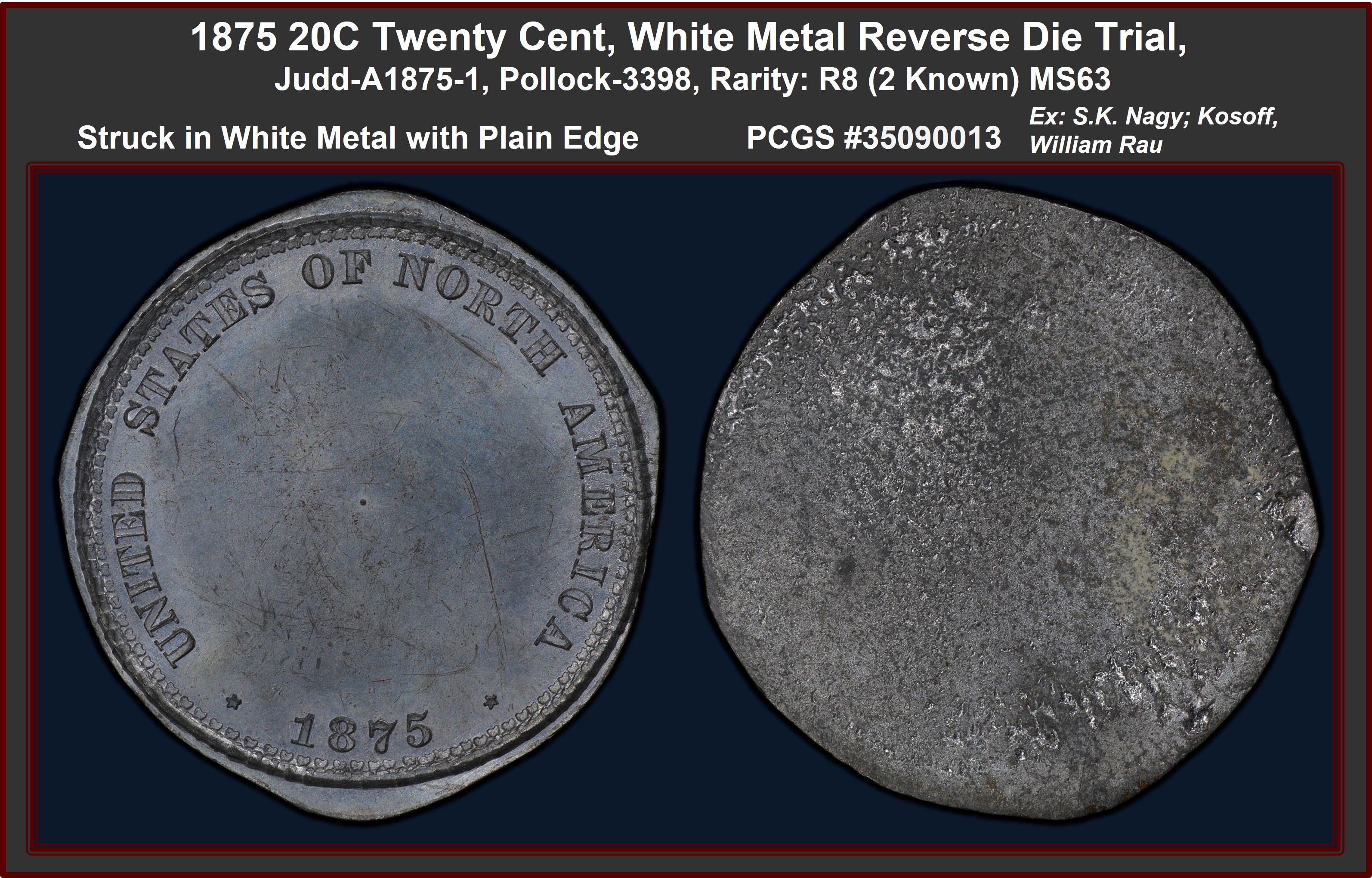
1875 20C Twenty Cent, White Metal Reverse Die Trial,
Judd-A1875-1, Pollock-3398,
Rarity: R.8 ( Only 2 known) MS63
Plate Coin Pollock fig 669
.
Struck in White Metal with plain edge
Obverse: This uniface die trial shows UNITED STATES OF NORTH AMERICA across the upper obverse with the date below. No central device is present.
Reverse: Unstruck
Comment:
This is one of two examples known. Saul Teichman, writing for USPatterns.com, explains: "It is unclear if this [is] for an obverse or a reverse design or if it is really for a 20 cent piece. It is more likely a design for a medal or token of some sort."
The pewter-gray obverse is partly lustrous, and the devices on that side are sharp. A small centering dot is apparent. The unstruck reverse is rough and porous.
20.0 Grains
Provenance/ Appearances:
Ex: S.K. Nagy; KOSOFF, A . 8/13/1958 ANA convention Auction sale /Lot #2050; Kosoff Sale (Bowers and Merena, 11/1985) / lot #1145; Superior (2/1991)/ Lot #1920 ; Early American History Auctions (12/2004) /Lot#1620 . The Collection of William Rau, Part II, Heritage Jun 2018 Expo - Long Beach / Lot #4983, Great Collections June 2020 (Passed)
|
| Slot: |
J-54 2C |
| Origin/Country: |
United States |
| Design Description: |
PATTERNS & TRIAL COINS 1792-1863 |
| Item Description: |
2C 1836 J-54 |
| Grade: |
PCGS PF 64 Red Brown Red Brown |
| Research: |
View Coin |
Owner Comments
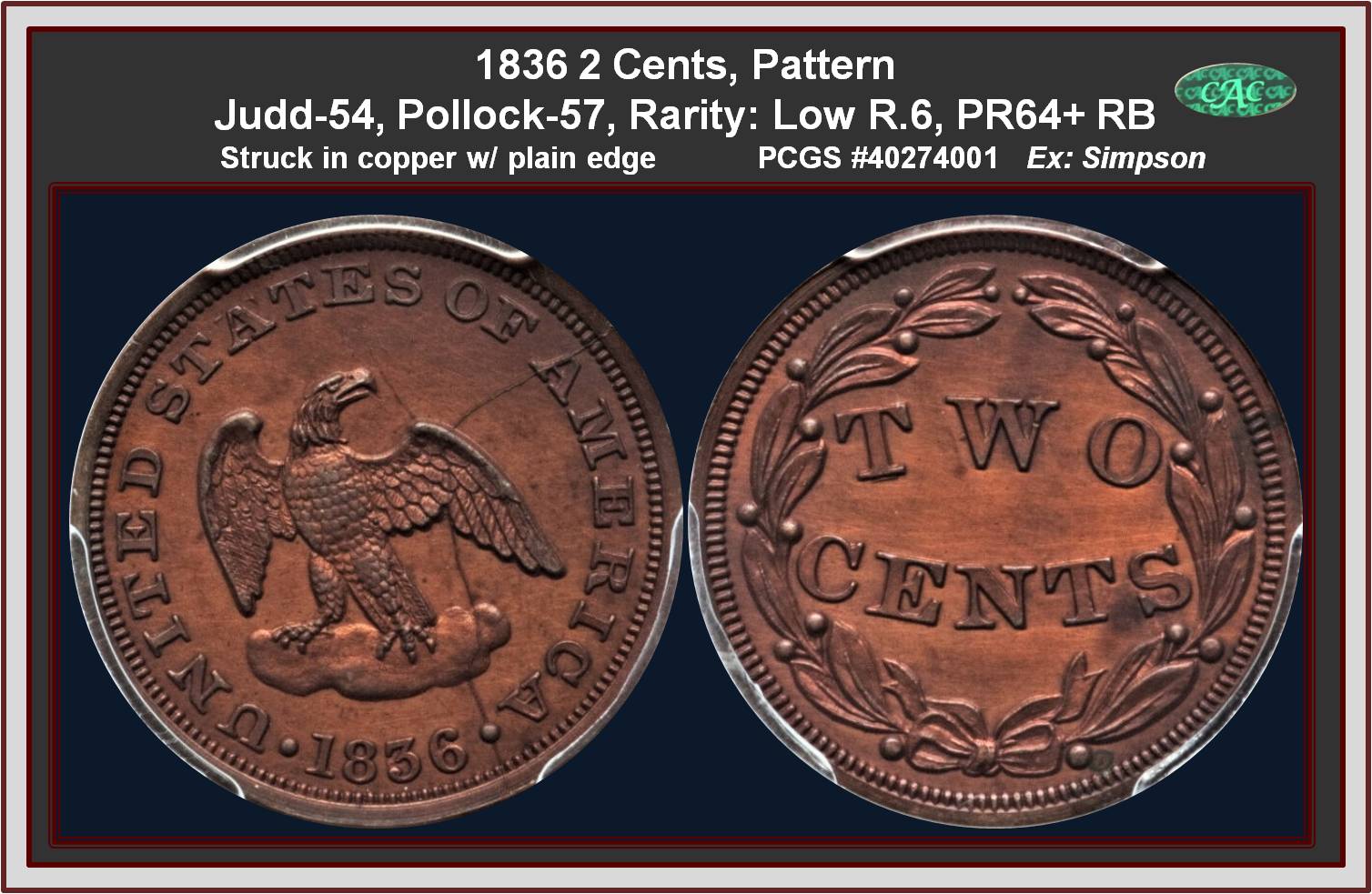
1836 2C
Judd-54, Pollock-57,
Rarity:Low R.6
PR64+ RB CAC Endorsed
Ex: Simpson/Pittman.
Struck in copper with Plain edge
Obverse: Features a standing eagle facing right and perched on a cloud, surrounded by UNITED STATES OF AMERICA and date 1836 separated by two dots. The obverse die shows the A in STATES corrected from an E underneath.
Reverse: Shows the denomination "TWO / CENTS" in arcs surrounded by an olive wreath.
Comment:
59.2 grains
Fiery orange fields contrast nicely against brown devices and lettering. Several blatant engraving errors clearly show, including an E originally cut in place of the Ain STATES, and the 6 first erroneously punched in the 3’s position. Sharply struck with a high wire rim. There are some light hairlines in the fields as well as several spots.
A die break runs in three directions from the eagle's right wing: 1) through the left side of the A to the rim; 2) down through the cloud and the stop between the date and AMERICA to the rim; and 3) from the top of the eagle's wing into the field, past the eagle's beak toward the E in STATES. Struck with dies parallel to each other, i.e. rotated 180 degrees from the normal “coin turn” of U.S. coinage. All of these characteristics indicate that this is a Restrike minted more than 20 years after the date on the coin. An estimated 20-25 examples are known
Provenance / Appearance:
From The Bob Simpson Collection Pt 2, Heritage Nov 2020 Auction /Lot 3096, Priors
Heritage June 2005 Long Beach (From The Western Hill Collection) / Lot #7353 (as NGC65RB);
David Akers Oct 1997 The John Jay Pittman Collection: Part 1 / Lot # 770 ($3080) with Note Prior Purchased by John Pittman for 55$ as Lot 5 from Abe Kosoff’s 1958 ANA Convention sale
|
| Slot: |
J-60 1$ |
| Origin/Country: |
United States |
| Design Description: |
SILVER DOLLARS - GOBRECHT, ALL METALS |
| Item Description: |
$1 1836 SILVER GOBRECHT J-60 |
| Grade: |
PCGS PF 55 |
| Research: |
View Coin |
Owner Comments

1836 1$
Judd-60, Pollock-55.
Rarity: R.1 Restrike issue.
Struck In Silver with Plain Edge
Obverse: Depicts Liberty seated on a rock holding a pole in her left hand with a cap of freedom perched on top, her right hand supports a shield draped with a ribbon inscribed LIBERTY. The entire obverse is free of legends otherwise, and the only device aside from Lady Liberty is the date below of 1836.
Reverse: There is an eagle in full flight, flying level in a starry field, with small and large stars. Surrounding the stars and eagle is UNITED STATES OF AMERICA / ONE DOLLAR with stops in between the denomination.
Comment: These were the first silver dollars struck for circulation since 1803, and although they were issued in tiny numbers the die was cast and in 1840 this series of silver dollars began production in earnest and these circulated more widely, although the designs were modified.
Christian Gobrecht was the third person to occupy the post of chief engraver at the Philadelphia Mint. His popularity is reflected in such terms used as “Gobrecht dollar” and “The Gobrecht Journal”. Among pattern coins his contributions are at once vital, beautiful, and far-reaching. Most known are his Liberty Seated coins, first made in Pattern form in this 1836 silver dollar, and continued across the denominations of half dime, dime, quarter dollar, half dollar, and silver dollar for years thereafter. Separately, Gobrecht's elegant flying eagle is an American numismatic icon. First used on the 1836 pattern dollar, it later appears on many other Patterns as well as regular issue 1857-1858 cents
This particular coin is quite impressive and desirable An lightly toned example with flashy surfaces and lovely antique silver-gray toning with deeper blue and russet accents surrounding the devices. The surfaces are sweet and smooth, with no detracting marks and the eagle's breast feathers are bold.
Provenance/ Appearance:
From Ira & Lee Goldberg June 2020 Pre-Long Beach Auction /Lot 654
|
| Slot: |
J-70 1$ Gilt |
| Origin/Country: |
United States |
| Design Description: |
PATTERNS & TRIAL COINS 1792-1863 |
| Item Description: |
G$1 1836 J-70 GILT |
| Grade: |
PCGS PF 64 |
| Research: |
View Coin |
Owner Comments

1836 PG$1 Gold Dollar
Judd-70 Gilt, Pollock-73
Rarity: Low R.7, PR64, CAC Endorsed
Ex: Simpson.
Struck in copper with a plain edge, and gilt
Obverse: The obverse displays a Liberty cap surrounded by a glory of rays with LIBERTY on the band, a motif reminiscent of the various Mexican silver coins of one to eight reales and fractions thereof that appeared in 1824.
Reverse: The reverse shows 1 and D. on two lines enclosed by a graceful palm frond, with the date below and UNITED STATES OF AMERICA around the rim..
Comment: The copper pieces are believed to be restrikes and only a dozen or so are known. This is a bright yellow-gold example that resembles a gold striking, just lacking the depth of mirroring one would see on a proof gold coin.
Dies by Christian Gobrecht, who interrupted his work on the second obverse of the silver dollar to complete these dies. Pieces were struck before March 14, 1836, as a letter of that date from the Mint Director to the Secretary of the Treasury enclosed a specimen in gold. The obverse design with Liberty cap surrounded by rays was directly copied from the series of silver coins struck by the Mexican Republic starting in 1823. Gobrecht had used the same design a few months before on his mint medals dated Feb. 22 and March 23, 1836 for the first steam coinage at Philadelphia (Qulian MT-20,21). Nearly the same designs (obverse and reverse) were used again in 1850 on a silver trime pattern (J-125), with the date moved to the obverse
Provenance/Appearances:
Ex: Bob Simpson, Heritage May 2022 CSNS/ Lot #3628; ; Prior
- Paramount Apr 1981 (Sutherland Collection) /Lot #2;
- Bowers & Merena Feb 1987 / Lot 2267
Video Link by Heritage on J-70 Not my specific coin but similar
|
| Slot: |
J-72 50C |
| Origin/Country: |
United States |
| Design Description: |
PATTERNS & TRIAL COINS 1792-1863 |
| Item Description: |
50C 1838 J-72 |
| Grade: |
NGC PF 60 |
| Research: |
View Coin |
Owner Comments
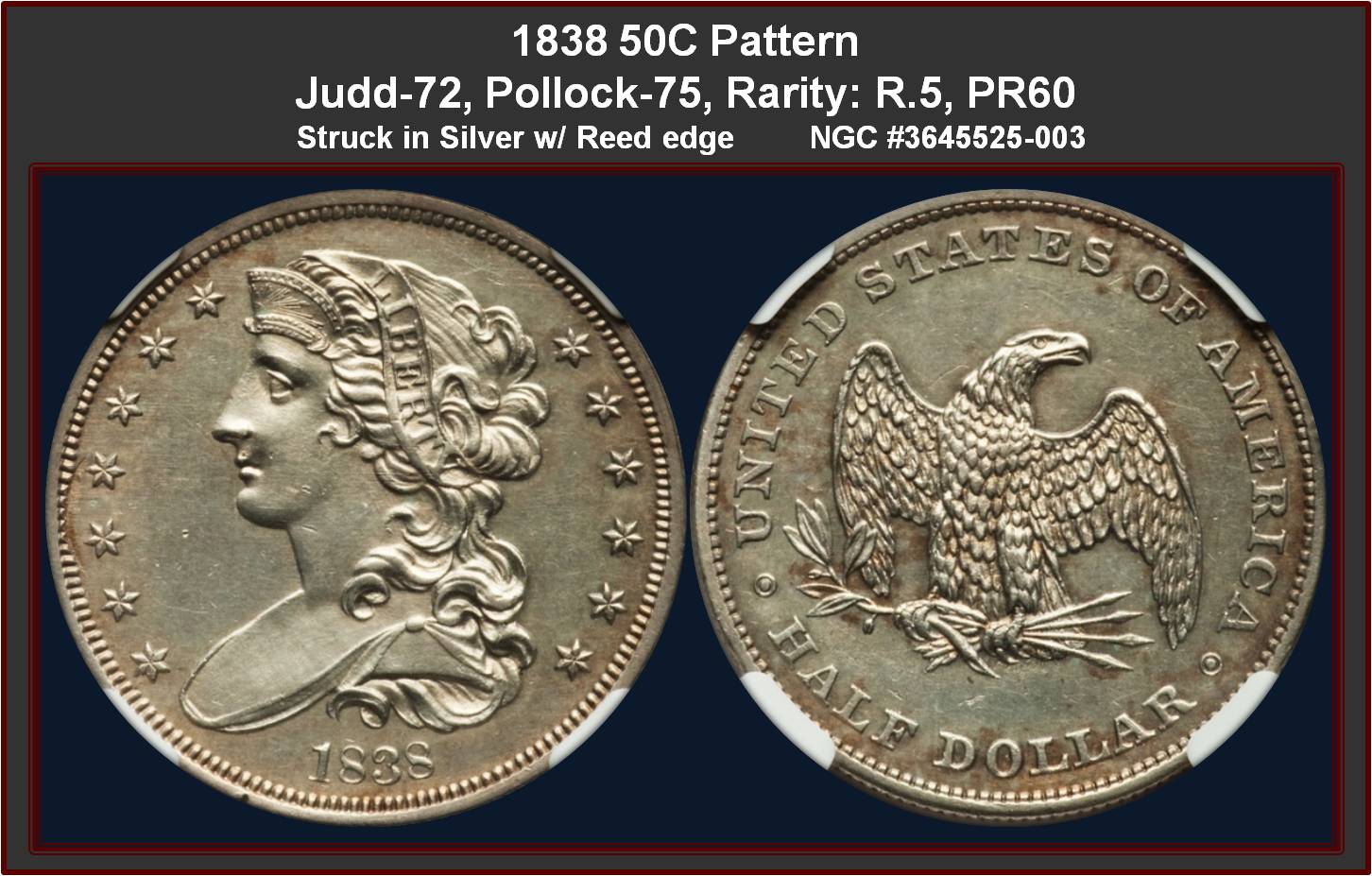
1838 50C
Judd-72, Pollock-75, (possible a restrike)
Rarity: R.5,
Struck in silver with a reeded edge and medal turn.
Obverse: A large bust of Liberty faces left, with 13 stars around and the date is below the bust. Miss Liberty is wearing a diahem and LIBERTY is inscribed on a ribbon.
Reverse: Features an eagle with spread wings holding an olive branch and her right talon is holding arrows. UNITED STATES OF AMERICA and the denomination are around the perimeter.
Comment: The obverse design is traditionally attributed to William Kneass, but Gobrecht was likely the engraver, since the portrait closely resembles the gold eagle also introduced in 1838.
A nicely struck specimen with pearl-gray and wheat-gold toning. The surfaces are slightly subdued and the left obverse field exhibits a few faded marks. An obverse planchet flaw near 9 o'clock is as made
Provenance / Appearance:
Heritage June 2014 - Long Beach / Lot #5531
|
| Slot: |
J-73
50c Bust Left - Gobrecht Liberty Head / Flying Eagle reverse
|
| Origin/Country: |
United States |
| Design Description: |
PATTERNS & TRIAL COINS 1792-1863 |
| Item Description: |
50C 1838 J-73 |
| Grade: |
NGC PF 63 |
| Research: |
View Coin |
Owner Comments
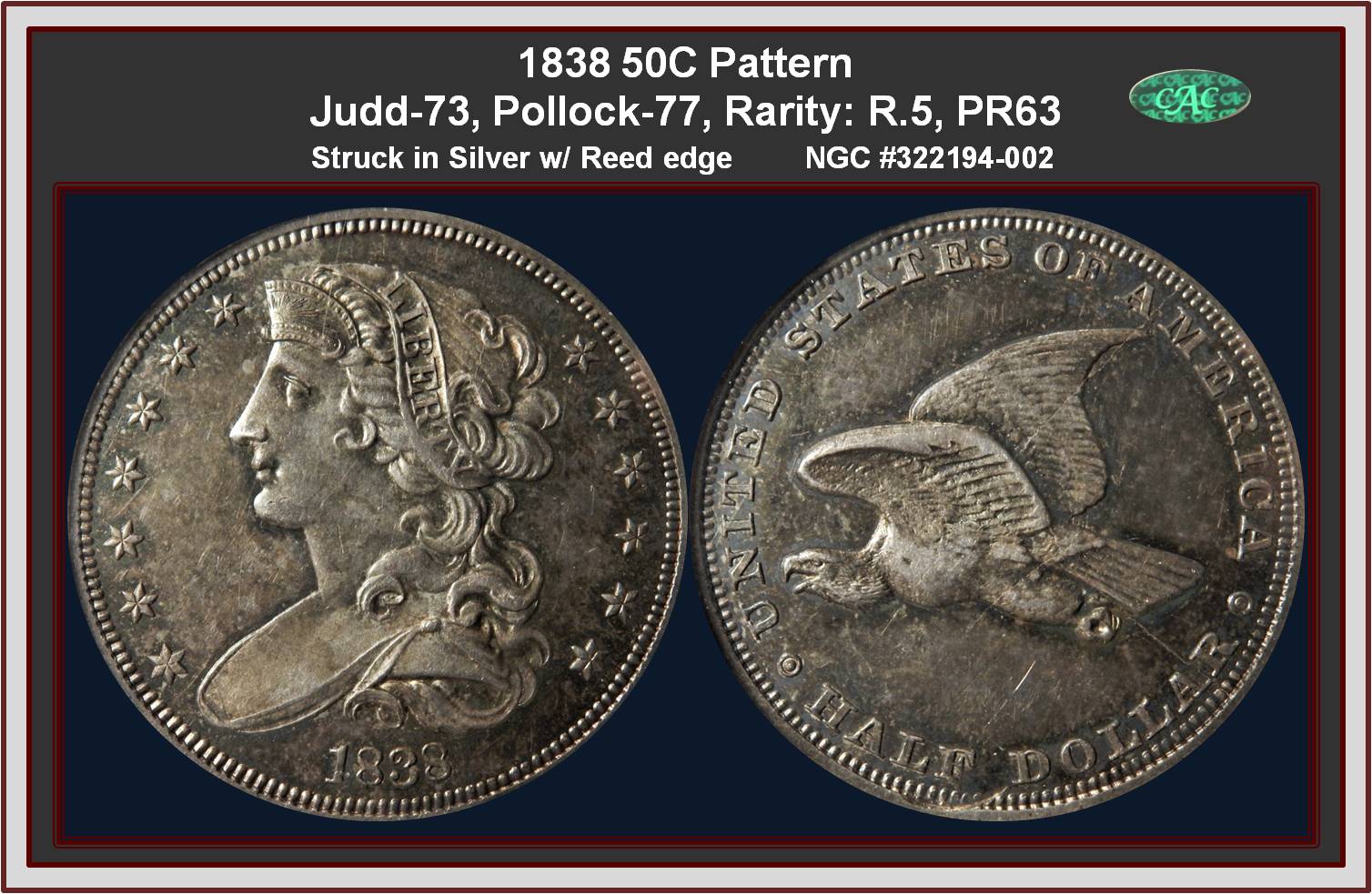
1838 50C
Judd-73,Pollock-77,
Rarity: R.5, PR63 CAC Endorsed
Struck in silver with a reeded edge
Obverse: Same as J-72, A large bust of Liberty faces left, with 13 stars around and the date is below the bust. Miss Liberty is wearing a diahem and LIBERTY is inscribed on a ribbon.
Reverse: A flying eagle facing Left with United Staes above and "HALF DOLLAR" below. The eagle may have been copied by Gobrecht from the Titian Peale sketch. 
Comment: Interesting to note the mouth of the eagle is open and Pollack III reference book shares the exchange between Treasury Woodbury and Mint Director Patterson about trying work it to have the Eagle mouth close.
This example is better struck than usual for a Judd-73, though the eagle's breast are incompletely brought up. Attractively toned in powder-tan, olive-green, and peach-gold shades and nice mirrors
provenance/ Appearances:
Greats Collections Oct 2016
|
| Slot: |
J-77 50C |
| Origin/Country: |
United States |
| Design Description: |
PATTERNS & TRIAL COINS 1792-1863 |
| Item Description: |
50C 1838 J-77 |
| Grade: |
PCGS PF 63 Red Brown |
| Research: |
View Coin |
Owner Comments

1838 50C (In Copper)
Judd-77 Restrike, Pollock-85
Rarity: High R.7 PR63 RB
EX Farouk/ Turoff
Struck in copper with a plain edge.
Obverse: Features the regular issue No Drapery Liberty Seated design
Reverse: A heraldic eagle holding an olive branch in its right talon and four arrows in its left is in the center and is similar to the two cent patterns from 1836.
Comment:
The restrike status of this piece is clearly seen by the extensive die rust on the reverse. The surfaces have an underlying bright, cherry-red color from an old cleaning that has since toned over to a great extent. Apparently only four pieces are known of this elusive pattern.
Specific characteristics prior to being slab is 150.8 grains. Diameter: 1.193 inches. Die alignment: about 10°.
Provenance/Appearances:
- Ex: Farouk Sale (Sotheby's, 1954), lot 1726;
- Cox Collection (Stack's, 4/62), lot 2191;
- Whitney Sunderland / Julius Turoff (Bowers and Merena, 3/1994), lot 1436;
- Superior May 1995 / Lot 3495 & Again Superior Jan 1996 Piedmont sale / Lot 1222 ( Not sold);
- Heritage Aug 1996 (ANA) / Lot 5069 & Heritage Mar 1997 (ANA) /Lot 6559 (Not Sold)
- Heritage Mar 2000 Central States Signature auction / Lot #7958.
- More recently from The Collection of William Rau Heritage April 2018 CSNS - Chicago / Lot #4482,
- Heritage Jan 2020 FUN / Lot #5855
|
| Slot: |
J-119
One Cent: Small annular cent w/hole in the middle |
| Origin/Country: |
United States |
| Design Description: |
PATTERNS & TRIAL COINS 1792-1863 |
| Item Description: |
1C 1850 J-119 |
| Grade: |
PCGS PF 63 |
| Research: |
View Coin |
Owner Comments

1850 1C
J-119 Original, Pollock-134
Rarity: Low R.6 PR63
Struck in billon (10% silver, 90% copper) with a plain edge and medal turn.
The annular cent pattern, with a largish hole in the middle. It is interesting to note that Judd describes the obverse in the convention manner, as the side with the date, while Pollock reverse the sides.
Obverse: displays the denomination CENT at the top, the date 1850 is at the bottom, two rosettes are on each side, and a perforation in the center. It is interesting to note that Judd describes the obverse in the convention manner, as the side with the date, while Pollock reverse the sides.
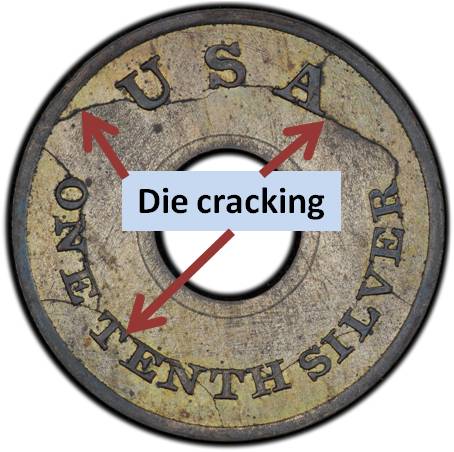 Reverse: USA inscribe at the top and "ONE TENTH SILVER" around at the bottom. It is curious the the U is not parallel to the rim on the inscription of USA. In the striking process of shattering and this piece shows the heavy die cracks that resulted. Reverse: USA inscribe at the top and "ONE TENTH SILVER" around at the bottom. It is curious the the U is not parallel to the rim on the inscription of USA. In the striking process of shattering and this piece shows the heavy die cracks that resulted.
Comment: Gray patina is seen over each side with bright, underlying silver-rose surfaces. A lovely example
With this pattern the Mint thought that a copper cent with a trace of silver, and in small diameter, could be produced to yield a profit. A problem with billon, was that the users of such coins had no way to notice the silver alloy, making them easy to counterfeit cheaply. Further, the making "holey" coins was a clumsy procedure.
Moreover, several years later on May 26, 1854, James Ross Snowden, then director of the Mint (since 1853), wrote to Secretary of the Treasury James Guthrie, noting that when eventually such billon pieces were redeemed after use, the cost of recovering the silver would exceed the value the silver metal obtained. Further: "The mechanical difficulties in making ring cents are not trivial. They lie not in planchet cutting but in stamping in ejecting the coin from the dies. I estimate that most of the value of a cent so formed would be sunk in the cost of striking."
Provenance/ Appearances:
Heritage Oct 2016 - Dallas / Lot #3963
|
| Slot: |
J-124
One Cent: Small annular cent (Center Not Punched) |
| Origin/Country: |
United States |
| Design Description: |
PATTERNS & TRIAL COINS 1792-1863 |
| Item Description: |
1C 1850 J-124 |
| Grade: |
PCGS PF 64 |
| Research: |
View Coin |
Owner Comments
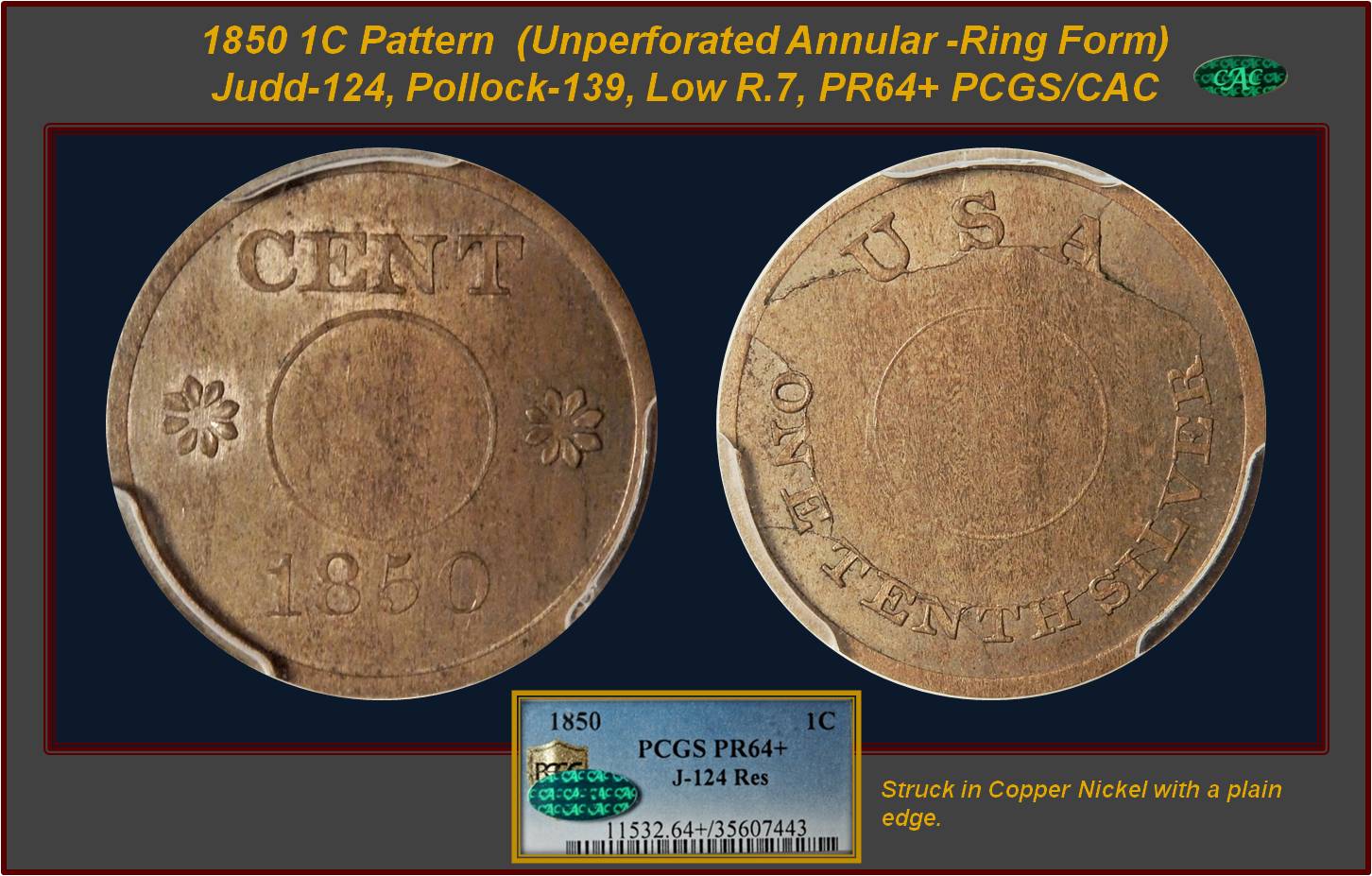
1850 P1C One Cent
Judd-124 Restrike, Pollock-139 --- same as the J-119 but without the perforation.
Rarity: Low R.7, PR64 + CAC Endorsed
Ex: Lumus
Struck in copper-nickel with a plain edge
Obverse: : CENT above place for undrilled hole, 1850 is beneath, floret are to either side of the unpunched hole.
Reverse: “USA” arcs above space for undrilled hole, and “ONE TENTH SILVER” curves below. Extensive die breaks on the reverse.
Comment: An experiment in producing a smaller-size cent piece, one intended, of course, to be produced in silver with a central perforation to lower the weight and corresponding silver content. The originals were produced in billon (90% copper, 10% silver), with weights from 24 to 26 grains, but they were too subject to counterfeiting, among other difficulties with the issue.
indicate the
The piece is is a Light gray-rose color covering both sides, with some minor flecks noted on both sides but nonetheless attractive. The reverse (ONE TENTH SILVER) side shows extensive peripheral die breaking through the legends. The die apparently shattered early during the striking of the original restrike status of this piece, of which only a half dozen or so are known.
Provenance/Appearance:
Private sale June 2019; Prior
|
| Slot: |
J-125
3 Cent - Liberty Cap Trime |
| Origin/Country: |
United States |
| Design Description: |
PATTERNS & TRIAL COINS 1792-1863 |
| Item Description: |
3CS 1850 J-125 |
| Grade: |
PCGS PF 63 |
| Research: |
View Coin |
Owner Comments
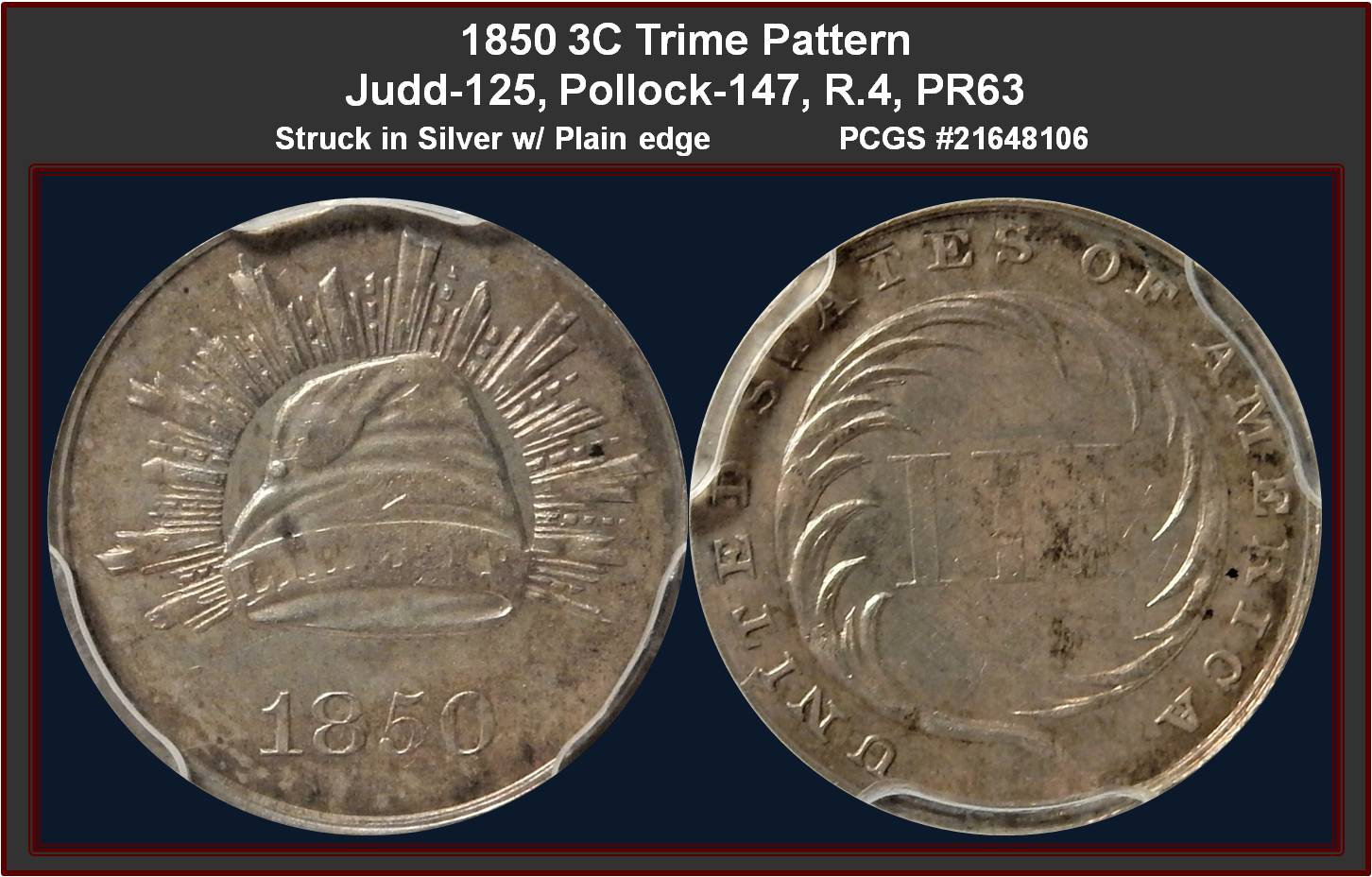
1850 3 Cent Silver
Judd-125, Pollock-147.
Rarity: R.4 .
Struck in silver with a plain edge
Obverse: Exhibits a liberty cap surrounded by a glory of rays with the date 1850 below. The word LIBERTY is inscribed on the band of the cap.
Reverse: A coiled palm frond encircles a Roman numeral III with the legend UNITED STATES OF AMERICA around the border.
Comment: An attractive design that artist Franklin Peale borrowed from Christian Gobrecht’s 1836 gold dollar pattern. James Barton Longacre prepared designs for this denomination in 1850. The dies for this pattern issue were prepared by Franklin Peale and were ready early in 1851. Obviously, the Longacre designs were preferred, since they were chosen for the final issue prepared for circulation
This diminutive pattern is subtly reflective with golden-violet toning that gathers strength at the margins. The centers are softly brought up and retain some of the planchet's rough texture. The Pollock reference records significant variance in planchet weights. Its strike suggests the present piece was coined from lighter stock.
Provenance/Appearances:
From Stacks March 2011 Baltimore Auction /Lot #6002; Prior
- Golberg Feb 2009 Pre Long Beach Lot #1322,
- Heritage Oct 2006 Dallas Signature Auction / Lot #2361;
- Heritage Aug 2004 Pittsburgh Signature Sale/ Lot #7874
|
| Slot: |
J-127
One Cent: Small annular cent w/hole in the middle (Undated) |
| Origin/Country: |
United States |
| Design Description: |
PATTERNS & TRIAL COINS 1792-1863 |
| Item Description: |
1C (1851) J-127 |
| Grade: |
PCGS MS 64 |
| Research: |
View Coin |
Owner Comments
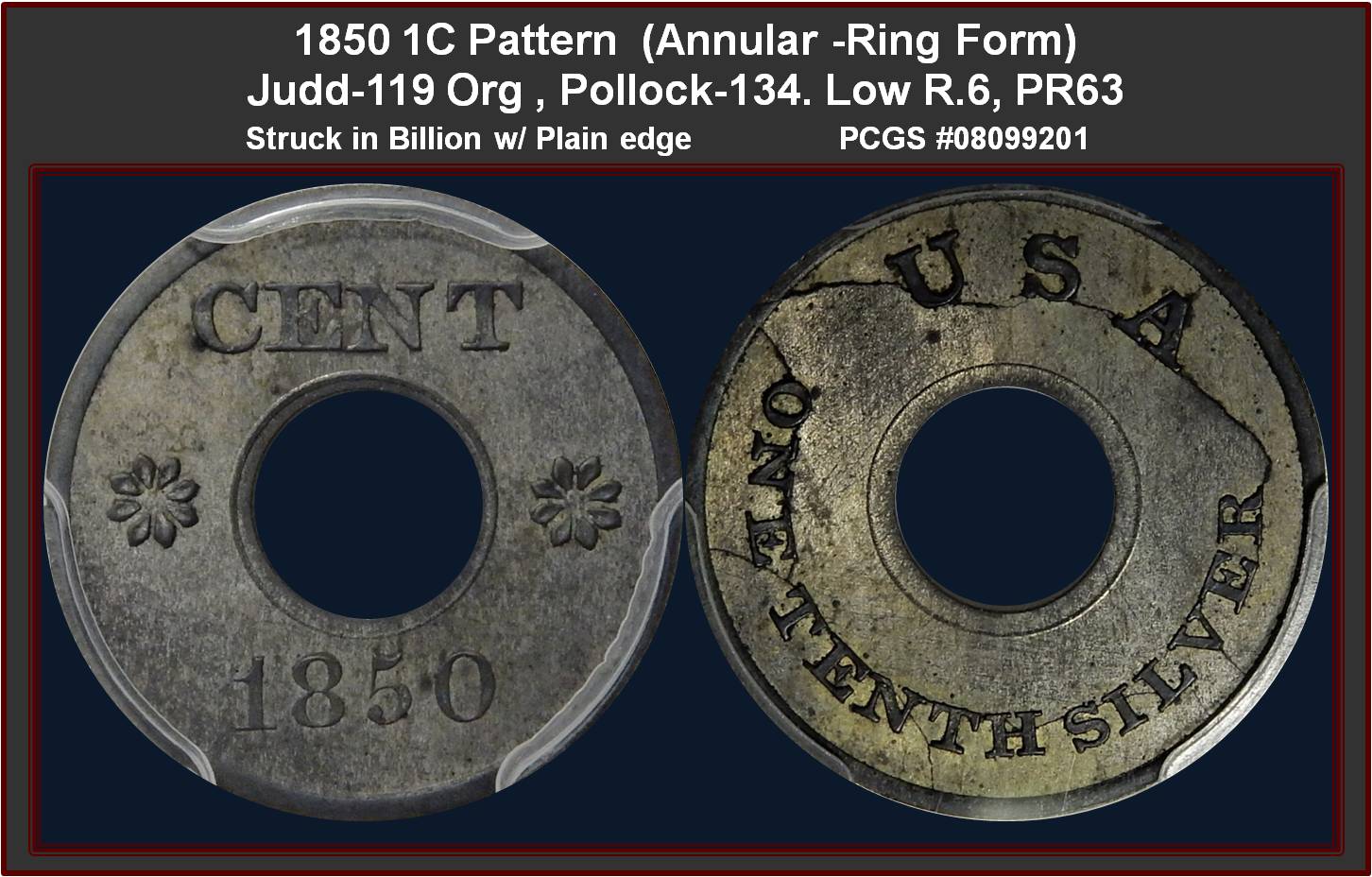
(1851) ONE TENTH
Judd-127 Original, Pollock-149,
Rarity: Low R.6; MS64
Struck in billon (10% silver, 90% copper) with a plain edge.
Obverse: Features CENT at the top and ONE TENTH SILVER at the bottom, Struck in 1851 these pieces are dateless
Reverse: Reverse depicts a laurel wreath and the legend UNITED STATES OF AMERICA.
Comment
Part of an effort to reduce the diameter of the cumbersome large cent but these were most likely struck just to test the materials as perforations was abandon in the prior year. This piece is center perforated, unlike restrikes.
The surfaces are hazy gray and there is a planchet lamination across much of the obverse. Sharply defined and otherwise well struck. Billion must be difficult to classify as Proof but no articles indicated a "Business Strike" for the J-127 even though PCGS has slabbed a couple J-127's as MS vs a proof designation
Provenance/ Appearances:
Heritage Aug 2017 ANA Auction - Denver / Lot #5393
|
| Slot: |
J-140
1$ Gold Ring |
| Origin/Country: |
United States |
| Design Description: |
PATTERNS & TRIAL COINS 1792-1863 |
| Item Description: |
G$1 1852 J-140 |
| Grade: |
PCGS PF 64 |
| Research: |
View Coin |
Owner Comments

1852 G$1 Annular Dollar in Copper-Nickel
Judd-140, Pollock-167
Rarity: Low R.7 PR64
Struck in copper-nickel with a plain edge.
Obverse: Only USA above the hole with 1852 below,
Reverse: A series of laurel sprigs amidst heavy concentric die lines. Curiously, no denomination is stated.
Comment:
One of the proposed solutions to the problem of the undersized and easily lost gold dollar was an annular pattern. The large center perforation (as struck) and narrow margin forces a simple design. Curiously, no denomination is stated.
The surfaces have toned a light brown but still retain the distinctive underlying golden-tan color common to copper-nickel alloy. Original, untampered surfaces with a couple of small, dark incrustations on each side.
Provenance/Appearance:
Private sale Jan 2019; Prior Heritage June 2017 Long Beach Expo Auction / Lot #4021
|
| Slot: |
J-148
1$ Gold Ring |
| Origin/Country: |
United States |
| Design Description: |
PATTERNS & TRIAL COINS 1792-1863 |
| Item Description: |
G$1 1852 J-148 |
| Grade: |
NGC PF 65 |
| Research: |
View Coin |
Owner Comments
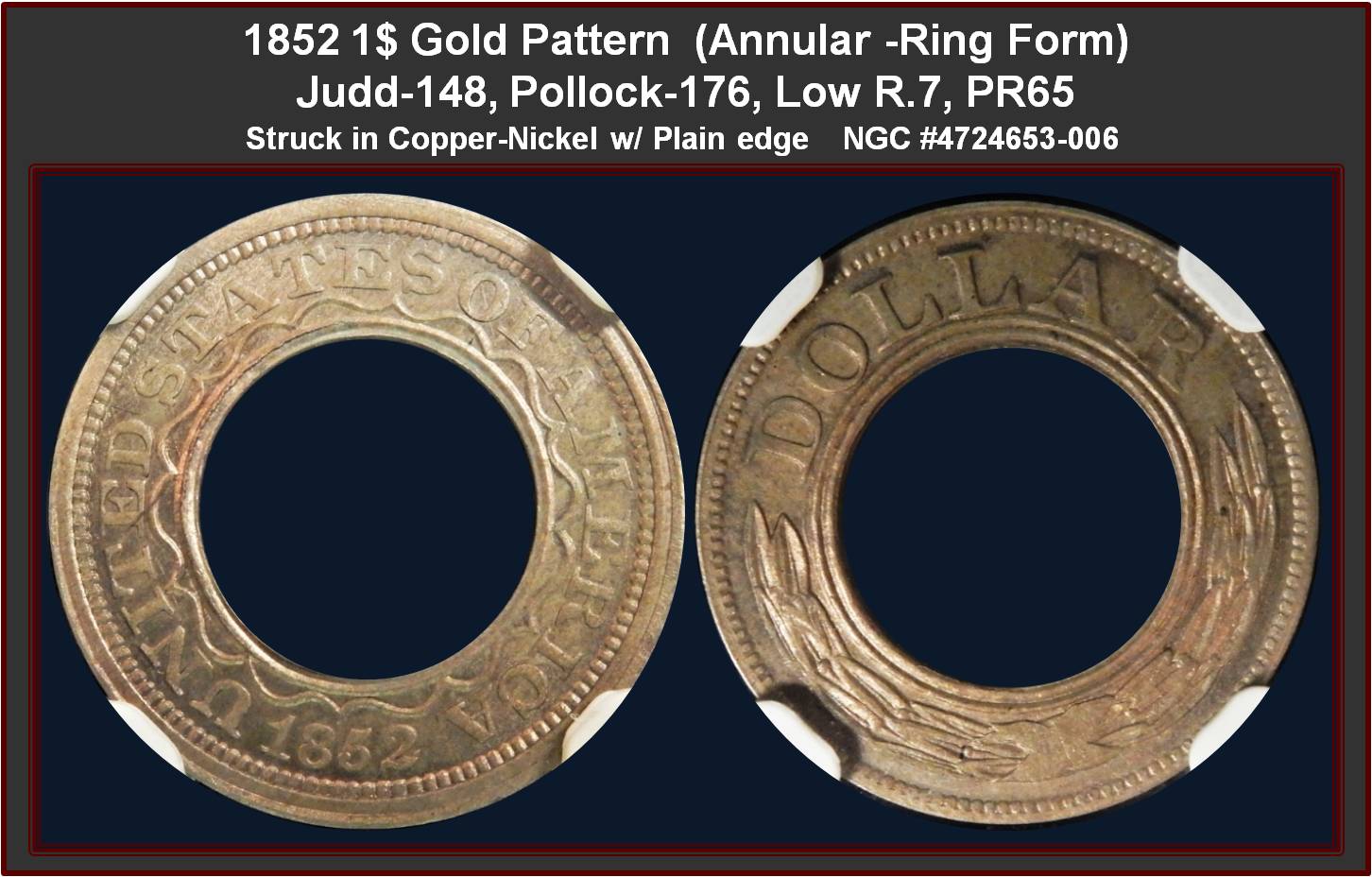
1852 G1$ Annular, or Ring-Form Pattern Gold Dollar
Judd-148, Pollock-176
Rarity: Low R.7 PR65
Annular gold dollar. Struck in copper-nickel with a plain edge.
Obverse: Annular gold dollar with perforation and UNITED STATES OF AMERICA and 1852 around ornamented raised rim.
Reverse: the simple wording for denomination "DOLLAR" and a wreath around a raised rim.
Comment:
A very interesting concept for the gold dollar. Starting in 1849 with the mass outpouring of gold from California, gold dollars were struck, but were tiny. In an effort to make the diameter larger and still maintain the legislated weight, a larger planchet was produced with a perforated hole in the center punched out
With the vast quantity of gold coins in circulation as a result to the California Gold Rush, the value of silver rose in relation to the price of gold, and silver began to disappear from circulation, particularly the silver dollar. As a result, many gold dollars were struck during these years where the silver dollar mintage dropped. The gold dollar as it was minted was small, and in an effort to enlarge the diameter of the denomination, the Mint experimented with these annular or ring shaped designs. Pollock designates the Judd-148 as "Probably a restrike," and notes that "thick and thin planchet varieties exist, per the Adam
Provenance/Appearance:
Private sale June 2019. Could not locate prior appearance
|
| Slot: |
J-151
One Cent: Liberty Bust Small Cent |
| Origin/Country: |
United States |
| Design Description: |
PATTERNS & TRIAL COINS 1792-1863 |
| Item Description: |
1C 1853 J-151 |
| Grade: |
PCGS PF 62 |
| Research: |
View Coin |
Owner Comments

1853 E1C One Cent
Judd-151, Pollock-178
Rarity: Low R.6, PR62 CAC Endorsed
Struck in Copper Nickel ( believed 40% Nickel / 60% copper) with Reeded Edge
Obverse: Liberty Head with 13 stars - same as regular issue 1853 Quarter Eagle
Reverse: The denomination of "One Cent" within a laurel wreath.
Comment:
This pattern issue combines the obverse of 1853 quarter eagles with a new reverse inscribed ONE CENT. Composition was copper-nickel alloy similar to the “German silver” alloy used by Lewis Feuchtwanger for his private cent patterns of 1837. This alloy combined copper, nickel, and zinc in various proportions.
Three such compositions were recorded:
40% copper, 40% nickel, 20% zinc;
30% nickel, 60% copper, 10% zinc; and
40% nickel, 60% copper.
Although each composition had its own inherent coloration, practical considerations suggest these cannot easily be distinguished by color alone. Specific gravity of these compositions do not provide the necessary distinction.
This piece is a lovely Pewter gray, with light striated toning visible on both sides. Some underlying reflectivity in the fields. A scratch is noted along Liberty's throat, but is not likely to be noticed without magnification.
Provenance/Appearances:
Purchased from Park Avenue Mar 2015; From the 1853 Collection. Stacks and Bowers Oct 2014 Winter Baltimore Sale/ Lot #1058, Prior Purchased privately from South Miami Rare Coins, Feb 1991.
|
|